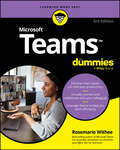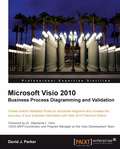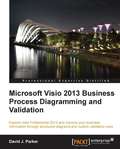- Table View
- List View
Microsoft Teams For Dummies
by Rosemarie WitheeUnlock the full power of Microsoft Teams, including brand-new AI functionality, with your friends at For Dummies Looking for a fast and easy guide to Microsoft Teams, the collaboration software used by millions of people and companies around the world? In Microsoft Teams For Dummies, 3rd edition, you'll find the must-know tips, hidden tricks, and handy hacks you need to help you rock your workday and get things done lightning-fast. You'll learn how to incorporate Teams into your everyday workflow and use functionality like chatting, file sharing, team organization, videochat, and more. You'll even learn how to use Microsoft's brand-new AI companion Copilot to help you improve your processes and productivity. You'll find out how to: Connect with colleagues and collaborate remotely, from across the hall or from the other side of the world Use little-known Teams features to help you supercharge your productivity and get more done in a day Customize your Teams installation and make it work better for you and your teammates An engaging and effective roadmap to one of Microsoft's most popular apps, Microsoft Teams For Dummies is a must-read for everyone who uses—or wants to use—this powerful software at work or anywhere else. Grab a copy today!
Microsoft Visio 2010 Business Process Diagramming and Validation
by David John ParkerA focused tutorial, this book provides a range of practical examples with downloadable code, showing you how to create business process diagramming templates with Visio and enabling you to effectively visualize business information. It draws on real business examples and needs, and covers all the new features of Visio 2010 Premium Edition. If you are a Microsoft Visio 2010 Premium Edition user or developer who wants to get to grips with both the basic features of Visio 2010 and the new Validation Rules in this edition, then this book is for you. A working knowledge of Microsoft Visio, and optionally .NET for the add-in code, is required, though previous knowledge of business process diagramming is not necessary. More experienced Visio users will gain valuable knowledge for building add-ins and creating and publishing rules. If you want to achieve results from Visio 2010 beyond the ordinary out-of-the-box features, then this book is ideal for you. Although this book covers the Premium Edition, much of the book is still useful if you are a Visio 2010 Standard Edition or Professional Edition user.
Microsoft Visio 2013 Business Process Diagramming and Validation
by David J. ParkerMicrosoft Visio 2013 Business Process Diagramming and Validation provides a comprehensive and practical tutorial including example code and demonstrations for creating validation rules, writing ShapeSheet formulae, and much more.If you are a Microsoft Visio 2013 Professional Edition power user or developer who wants to get to grips with both the essential features of Visio 2013 and the validation rules in this edition, then this book is for you. A working knowledge of Microsoft Visio and optionally .NET for the add-on code is required, though previous knowledge of business process diagramming is not necessary. More experienced Visio users will gain valuable knowledge regarding building add-ons and creating and publishing rules. If you want to achieve results from Visio 2013 beyond the ordinary out-of-the-box features, then this book is ideal for you. Microsoft Visio 2013 Business Process Diagramming and Validation provides a comprehensive and practical tutorial including example code and demonstrations for creating validation rules, writing ShapeSheet formulae, and much more.
Microsoft Windows Identity Foundation Cookbook
by Sandeep ChandaThis book is written in a simple, easy to understand format, with lots of screenshots and step-by-step explanations.If you are a .NET developer looking forward to building access control in your applications using claims-based identity, then this is the best guide for you. This book is also an excellent choice for professionals and IT administrators trying to enable Single Sign-On across applications within the enterprise, and in the cloud spanning interoperable platforms. No previous knowledge on the subject is necessary, however a strong foundation in the C# programming language and .NET Framework 4.0 is expected. A good understanding of authentication and authorization concepts (Windows and Forms based) in .NET would also help
Microsoft Xbox: Changing the Game?
by Andrei HagiuIn September 1999, the Microsoft Xbox team was wondering which strategic choices would give it the best chance against the upcoming Sony PlayStation 2. Initially called "Project Midway" within Microsoft, the console project was intended to counter the perceived threat to the Windows franchise posed by Sony expanding the original PlayStation into a broad entertainment platform with the PlayStation 2. Seamus Blackley--the chief instigator for the Xbox within Microsoft--and some of his colleagues were on a flight to Austin, Texas, where they had an appointment with Michael Dell, CEO of Dell Computer. The purpose of the visit was to convince Dell to manufacture Xbox videogame consoles running Microsoft software. Indeed, the team intended to produce a machine somewhere between a standalone videogame console and a PC tailored to play videogames. It remained unclear, however, where along the spectrum from dedicated console to PC Microsoft should position the Xbox. Would it be an open platform like the PC in the sense that independent developers could publish games on it with no restrictions and without having to pay royalties? Who would produce consoles and under what arrangements? What features should the console include, and how would it be priced to consumers? The home videogame industry had been born in the 1970s during the Atari "golden age", then collapsed suddenly in 1983. It was reborn at the end of the 1980s under Nintento's leadership, which was then challenged for a few years by Sega, only to be conquered by Sony's original PlayStation. And along the way, some companies such as 3DO had tried unsuccessfully to change the prevalent business models. This tumultuous 25-year history might provide Blackley and his colleagues with some useful tips on how best to enter the market.
Microsoft adCenter
by Peter A. Coles Benjamin EdelmanMicrosoft considers alternatives to expand its presence in online advertising, especially text-based pay-per-click advertising. Google dominates, and it is unclear how Microsoft can grow, despite considerable technical and financial resources. Microsoft considers a set of alternatives, each with clear benefits but also serious challenges.
Microsoft and Metro: Foreign Investors in China and India
by Tarun Khanna Elliott N. WeissThis chapter looks at what it takes for multinationals to succeed in China and India using the cases of Microsoft in China and the German firm, Metro Cash & Carry, in India.
Microsoft in 2002
by David B. Yoffie Carl Johnston Michael G. Rukstad Tyrrell LevineExamines Microsoft's strategy and competitive position as it prepares to launch Windows XP. The discussion explores how Microsoft builds and sustains its competitive edge.
Microsoft in 2005
by David B. Yoffie Dharmesh M. Mehta Rudina I. SeseriFocuses on Microsoft's strategy for sustaining competitive advantage in the global software industry. Also, explores Microsoft's history and its current position, as it tries to diversify its product and service revenue streams.
Microsoft in China and India, 1993-2007
by Tarun Khanna Prithwiraj ChoudhuryRelates to Microsoft's expansion in China and India in the period 1993-2007 and the strategic issues faced by multinationals in emerging markets.
Microsoft in the Mirror: Nineteen Insiders Reflect on the Experience
by Karin CarterFormer and current employees of Microsoft share their experience.
Microsoft in the People's Republic of China--1993
by Tarun KhannaExplores some of the economic and political tradeoffs that need to be negotiated by a firm seeking to influence industry structure. The setting is the nascent personal computer software industry in the People's Republic of China (PRC) in 1993. Microsoft has to localize its software products for use in the PRC. This localization can either be done in-house by Microsoft, or can be contracted to the local software vendors. Explores the costs and benefits of full integration and arm's-length market transaction. Also discusses the "holdup" problem that arises when assets specific to a particular partnership are created.
Microsoft's Financial Reporting Strategy
by Dawn Matsumoto Robert BowenExplores Microsoft's overall financial reporting strategy by examining the company's treatment of two accounting issues--software capitalization and revenue recognition. For both issues, the company selects accounting methods that are relatively conservative. Also discusses the issue of managing analysts' expectations and Microsoft's tendency to provide analysts with very conservative expectations for the future. Provides a forum to discuss possible reasons for Microsoft's accounting and disclosure choices and also discusses the Securities and Exchange Commission's recent investigation into Microsoft's accounting practices.
Microsoft's Search
by Jan W. Rivkin Eric J. Van Den SteenIn 2008, executives at Microsoft must decide how to compete against Google in the market for Internet search and advertising. The case describes how Microsoft has responded to a set of competitive threats in the past; how Google has gained a dominant position in Internet search and advertising; and what Microsoft has done so far in its as-yet-unsuccessful effort to catch up with Google. The case then challenges students to construct a strategy that will allow Microsoft to achieve its objectives in the evolving market for search and advertising.
Microsoft's Unlimited Potential (A)
by V. Kasturi Rangan Marie BellIn April 2007, Bill Gates announced Microsoft Unlimited Potential. Its mission was to enable social and economic opportunity for the next five billion people. To deliver against this mission, Microsoft sought to focus its citizenship efforts and its product development efforts in developing markets. This case traces the development of Unlimited Potential on the citizenship side and the business operations side, raising the questions of whether Unlimited Potential is a robust strategy for the company and if so, how the company should organize and execute to achieve its mission.
Microsoft's Vega Project: Developing People and Products
by Christopher A. Bartlett Meg WoznyWith a focus on Matt MacLellan and his careful development as a project manager under his boss and mentor, Jim Kaplan, the case describes the evolution of Microsoft's human-resource philosophies and policies and illustrates how they work in practice to provide the company with a major source of competitive advantage. It looks at employee development, motivation, and retention efforts in one of Microsoft's product groups. Dissatisfied with his project management role, MacLellan decides to become a developer despite the fact that he has never written code professionally. Kaplan is faced with the decision of whether to support his protege's radical career shift, and if so, how to do it not only to MacLellan's satisfaction but also in the organization's best interest.
Microsoft's aQuantive Acquisition
by Gwen Yu Christopher F. Noe Joseph Weber Thomas SamuelsonThis case introduces students to the topic of mergers and acquisitions. At the time that Microsoft purchased aQuantive there was a mixed reaction by analysts and investors on whether this transaction would increase shareholder value. Ultimately the transaction turned out to be a colossal failure, and Microsoft received a substantial amount of bad press. This case allows students to discuss firm's grow strategies (through mergers and acquisitions vs. organic growth) from both an economic perspective and through the accounting lens. The case offers an opportunity to introduce accounting for mergers and acquisitions, i.e., purchase price allocation rules, and other specific accounting issues associated with mergers and acquisitions in the internet advertising setting.
Microsoft/Intuit
by William E. FruhanMicrosoft Corp. proposes to acquire Intuit Corp. Examines the strategic fit and the price proposed to complete the transaction.
Microsoft: Competing on Talent (A)
by Christopher A. Bartlett Meg WoznyDescribes the evolution of Microsoft's human-resource philosophies, policies, and practices and how they used as a core of the company's competitive advantage. In particular, the focus is on how Microsoft tried to retain its ability to recruit, develop, motivate, and retain first-class talent as it grew from a start-up to a global behemoth. Triggered by high-profile, senior-level departures in 1999, the company must decide if it is time to change its "hard core" culture came to be.
Microsoft: Launching the Smart Watch
by Christina Darwall John T. GourvilleMicrosoft is on the verge of launching its Smart Watch technology, which will allow specially designed watches to receive up-to-date information on sports, business, traffic, news, etc. After several years of effort and millions of dollars spent, the questions now revolve around launch strategy and likely consumer adoption. Is this the next big thing for Microsoft or is this a waste of money and resources? Complicating the matter is the fact that although Microsoft designed and will operate the technology to deliver information to these watches, the watches themselves will be sold and marketed by several prominent watch-making partners.
Microsoft: Positioning the Tablet PC
by Youngme MoonMicrosoft is preparing for the launch of the Tablet PC, which allows users to use a pen (stylus) to run Windows and Windows applications, annotate documents, and create handwritten documents for later reference or even conversion to text. Microsoft's original equipment manufacturing partners are developing the Tablet PC hardware, while Microsoft develops the software (the Windows XP Tablet Edition). The Microsoft Tablet PC team is grappling with two critical issues related to the final marketing plan. The first concerns the positioning of the Tablet PC. One option is to position the device as a radical breakthrough in computing technology that will dramatically change the role of computers in the workplace and home. A much more conservative option is to position the Tablet PC as merely a high-end laptop with several interesting new features. The second concerns the initial target market for the device. Includes color exhibits.
Microsoft: Positioning the Tablet PC
by Youngme MoonMicrosoft is preparing for the launch of the Tablet PC, which allows users to use a pen (stylus) to run Windows and Windows applications, annotate documents, and create handwritten documents for later reference or even conversion to text. Microsoft's original equipment manufacturing partners are developing the Tablet PC hardware, while Microsoft develops the software (the Windows XP Tablet Edition). The Microsoft Tablet PC team is grappling with two critical issues related to the final marketing plan. The first concerns the positioning of the Tablet PC. One option is to position the device as a radical breakthrough in computing technology that will dramatically change the role of computers in the workplace and home. A much more conservative option is to position the Tablet PC as merely a high-end laptop with several interesting new features. The second concerns the initial target market for the device. Includes color exhibits.
Microsoft® Access® 2010 Inside Out
by John Viescas Jeff ConradYou're beyond the basics, so dive right in and really put your database skills to work! This supremely organized reference is packed with hundreds of timesaving solutions, troubleshooting tips, and workarounds. It's all muscle and no fluff. Discover how the experts tackle Access 2010 -- and challenge yourself to new levels of mastery! Master essential data management and design techniques Import and link to data from spreadsheets, databases, text files, and other sources Use action queries to quickly insert, update, or delete entire sets of data Create custom forms to capture and display data Design reports to calculate, summarize, and highlight critical data--and learn advanced techniques Automate your application with macros and Visual Basic® for Applications (VBA) Use Access Services to extend your database application to the Web A Note Regarding the CD or DVD The print version of this book ships with a CD or DVD. For those customers purchasing one of the digital formats in which this book is available, we are pleased to offer the CD/DVD content as a free download via O'Reilly Media's Digital Distribution services. To download this content, please visit O'Reilly's web site, search for the title of this book to find its catalog page, and click on the link below the cover image (Examples, Companion Content, or Practice Files). Note that while we provide as much of the media content as we are able via free download, we are sometimes limited by licensing restrictions. Please direct any questions or concerns to booktech@oreilly.com.
Microsoft® Excel Data Analysis and Business Modeling
by Wayne WinstonNow you can apply the techniques that business analysts at leading companies use to analyze and transform data into bottom line results. For more than 10 years, well- known consultant and business professor Wayne Winston has been teaching corporate clients and MBA candidates the most effective ways to use Microsoft Excel for data analysis, modeling, and decision making. This practical, business-focused guide delivers the best of Winston's classroom experience to you-from asset allocation modeling to estimating exponential growth, forecasting sales, optimizing portfolios, and other critical functions. You also get all the book's sample files on CD-ROM - ready for use in your own work.





